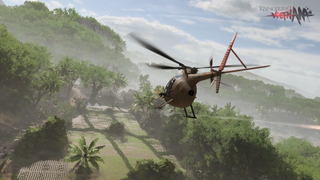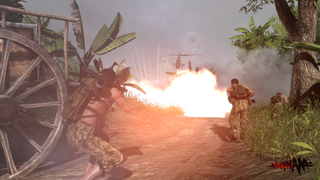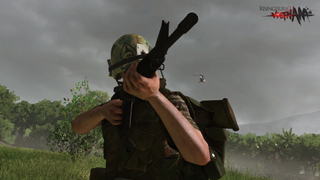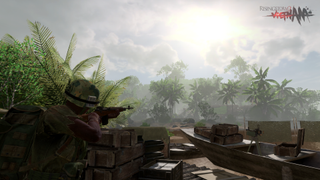Hands-on with Rising Storm 2: Vietnam's helicopters, tunnels, and guns
Rising Storm 2 pushes the asymmetry of Rising Storm into the air and under the ground.
Tripwire and Antimatter Games aren't interested in describing why the Vietnam War was fought, only how it was fought: tunnels, traps, napalm, and loud ass helicopters splashing the tops of jungle trees. I flew one of those helicopters, a Huey, and nervously landed it—wobbling and skidding—in a cleared patch of jungle to unload a squad near a vital capture point. I took off while my troops ran, and then from somewhere in the brush a rocket-propelled grenade whizzed into the air, into my rotor. It was all flames and trees after that. The title of a ’70s war movie could have been overlaid on my wreckage right then.
Rising Storm 2: Vietnam, the follow up to Rising Storm and the Red Orchestra series of realism-focused multiplayer FPSes, is mostly the tension part of the war movie. It’s a lot of slow, creeping movement, a lot of thinking about my positioning and the enemy’s positioning, and then a burst of action—automatic rifles and explosions and the part where a bunch of extras die. (You're the extra.)
And it isn’t strictly from an American perspective. As with the other games in the series, Antimatter (which is based in Cornwall), is not taking sides: this is all about weapons and tactics, a reenactment of war that cares only about how these very different armies won and lost and whether or not we can get into their heads and play out their movements.

“I know there’s still a lot of feelings about this particular war, since it is still in quite a lot of living people’s memories,” said lead programmer and designer Sturt Jeffery, “But we don’t take any sides here. It’s just one side fighting another side in a war that could’ve been right, could’ve been wrong, we’re not going to weigh in to that. It’s about the battles, the tactics, for us, and making sure both sides are treated fairly, and nobody’s being demonized, and we’re not making one to be better than the other.”
In researching the game, the team visited Vietnam several times and producer Jack Hackett said he read memoirs from North Vietnamese soldiers which informed some of the tactics and dialogue—dialogue referring to contextual lines you’ll hear in combat, as there’s no story outside the structure of the battles. What they came up with, which I played an unfinished version of with testers, is a multiplayer reenactment of the Vietnam War that is likely unmatched in its attention to detail.

Asymmetrical warfare
To be fair, Vietnam hasn’t been attempted many times in videogames—certainly not as often as World War 2—and I wouldn’t say Rising Storm 2 is exactly realistic. Something like Arma and its many possible ways to sit, stand, and lie down tries harder at putting us in real bodies, where Rising Storm 2 is more interested in pairing action with a broader concern for authenticity—how military technology works and how different armies operated, with leeway here and there to make it fun. One thing particularly exciting is how the asymmetry of the first Rising Storm, which pit American semi-autos and flamethrowers against Japanese bolt-actions and swords, has become more elaborate and striking in Vietnam.
You’d think giving one side flying cannons would entirely tip the scales, but it doesn’t.
The Viet Cong do not have helicopters. They did have helicopters during the war, but didn’t fly them south of the border, says Jeffery, as “they knew what would happen if they did.” So in maps and modes which involve helicopters, only the Americans can fly them by spawning as attack and transport pilots at an airfield secluded away from the capture points. You’d think giving one side flying cannons would entirely tip the scales, but it doesn’t.
PC Gamer Newsletter
Sign up to get the best content of the week, and great gaming deals, as picked by the editors.
The Americans are loud. You can hear helicopters from across the map. The VC, on the other hand, bolt through tunnels—both actual tunnels built into the map and ‘spawn tunnels’ which squad commanders can dig, and which act as mobile spawn points the Americans are forced to hunt and destroy. The Viet Cong can also avoid detection by American scout helicopters by staying crouched and still or going fully prone. They can be anywhere, while it’s pretty obvious that the Americans are coming from the direction of the Huey that just roared across the map. Two completely different forms of mobility.

And because some Americans need to work as pilots, they have fewer soldiers on the ground attacking points. Plus, piloting wasn’t exactly a safe job in Vietnam—mounted guns and RPGs can make it hell—and it’s challenging to fly, at least for inexperienced me. While not meant to be hyper-accurate flight simulations, the helicopters are certainly trickier to control than they are in the Battlefield series, and as they take damage they become even harder to keep upright. Even in the gunner’s seat, I struggled to see or hit anything as we circled the map, and needed teammates marking targets so I at least had some idea of where to shoot.
Antimatter wants to achieve a roughly 50/50 win-loss ratio for each side on each map, but it’s balancing the sides in terms of interesting tactics and maneuvers, not pure parity.
I love that Antimatter has taken this approach to the American and VC armies. The word ‘balance’ is so often lobbed into discussions about game design as if it’s a single, incontrovertible idea. Antimatter does want to achieve a roughly 50/50 win-loss ratio for each side on each map, but it’s balancing the sides in terms of interesting tactics and maneuvers, not pure parity.
This is actually a slightly different approach than the team took for the first Rising Storm. Jeffery tells me that in RS1, the teams were unbalanced, so the maps had to be unbalanced in the other direction to even it out. This time, the teams should be able to compete regardless of which way they’re going. Obviously any maps designed to include helicopters (not all do) require some design specific to each team—you couldn’t spawn the Viet Cong in an airfield they can’t use—but no soldier has an inherent advantage over the other. It’s Type 56 AK-47 vs M16, and there’s no clear winner, so maps shouldn’t have to be tilted.
I asked how, with so many variables—guns, explosives, commanders (one player on each team who can call in scout planes and airstrikes), and helicopters—they can make sure both sides are going to have fun. It’s a lot of testing, and also a lot of throwing out ideas. While Antimatter decided on everything that should be in Rising Storm 1 from the beginning, it took a different approach this time, trying out everything they thought might work and throwing out what didn’t, including “dozens” of maps. One of the things that came from that process is a daunting new game mode.

Land grab
Rising Storm 2 maintains the series-standard offset Territories mode, in which one side must work its way across the map capturing points while the other defends. The new Supremacy mode, however, is more like Battlefield in that the map is wide open and you can go after any point you like—something Tripwire and Antimatter developed as they looked for ways to represent the more open, guerrilla warfare of Vietnam as opposed to WWII's lines. But rather than running down some number of enemy tickets by holding territory as in Battlefield, Supremacy is a tug of war. Every few seconds, the difference between the American and Viet Cong-held bases pushes a bar in one direction or the other, so it’s possible to be near defeat and then start shoving the bar back until you have the advantage.
The smarter team will disrupt and distract the enemy.
What especially makes Supremacy more challenging than Territories is that each point actually represents a large piece of territory on the map which borders other territory, and teams can only earn points from territory they own if it’s connected to their home base. Say the Americans control all the points and are quickly nearing victory: If I, as the Viet Cong, were to take the point directly adjacent to their base, cutting it off from all the other points, I could stall their victory (though they’d still earn a few points from their home base). So it’s very important which points you attack and defend (some are worth more than others, too), which makes the commander and squad leaders integral to victory—someone has to be looking at the map, figuring out where the enemy is going, and calling the shots in voice chat.
“Both sides can play it like a straight-up Territory match and go toe-to-toe,” says Tripwire vice president Alan Wilson. “The smarter team will disrupt and distract the enemy.” The US, for instance, can have players use their binoculars to set targets on top of key objectives. The commander will then wait for VC sneak attacks to call in artillery or napalm or an AC-47 Spooky, which summons several seconds of circling 7.62mm minigun fire on the target. The VC, meanwhile, can call in its own strikes, fill objectives with traps, and harass Americans with well-placed spawn tunnels.

In practice, this is all pretty tough to jump into. I had no sense of where the enemy might be—which is partially the right feeling to have if you’re on the American side—or what to focus on. In my defense, I was trying to ask questions to the developers while also listening to my squad leader and deciphering the user interface, something Antimatter recognizes needs work.
It always takes me a little while to adjust to playing a Red Orchestra or Rising Storm game, where a single bullet from who-knows-where can kill you. Eventually I found a nasty camping spot behind a building across a flat field from a Viet Cong spawn tunnel. I watched them sprinting across the flatland toward a hill and started spraying them with my M3A1 Grease Gun. A couple fell before I was shot in the back.
The sights of some of the guns are grimey and overbearing, and the sniper rifles especially give you tiny scopes to peer through.
The guns may be automatic in Vietnam, but they aren’t necessarily easier to use than in the first Rising Storm, with its bolt-action and semi-auto guns. Held at the hip, they don’t fire at an invisible reticule in the center of the screen, instead firing exactly where the barrel is pointing, somewhere off to the right of your body. Suppression is more effective in RS2, and exhaustion causes significant gun sway. The sights of some of the guns are grimey and overbearing (the M3A1 especially), and the sniper rifles give you tiny scopes to peer through.
On one very unfinished Territories map, I set myself up on the third floor of a half-untextured building peeking out of a smashed wall at a tower about 300 yards away. I knew the Viet Cong were hanging out in that tower from a prior experience—getting killed repeatedly. So I lay there and waited, my M16 sights blocking much of my view. When I thought someone was up there, I fired in bursts, mostly blasting at the stone. Every now and then, in the upper-right corner of the screen, I would see a kill notification with my name at the front.

Shell shock
Like the others in the series, Rising Storm 2 won’t be an easy game for newcomers, as much as Antimatter and Tripwire will try to help out with tooltips and training. Anyone used to clearly-marked enemies, not accidentally killing teammates, and guns with simple and predictable recoil is going to have a hard time at first. After you spot an enemy in Overwatch, for instance, you can chase them around and have a duel that spans half the map. In RS2, they might disappear behind a small hill a couple seconds after you take your first shot—and chasing them will probably get you killed in as many seconds. Half the time I’m shooting at dirt, hoping that even if I don’t score a hit, my suppression is helping keep someone away from a point. I once spent 10 seconds shooting at a teammate because I didn’t hover my sights over him long enough to see his name tag. That’s embarrassing.
I’m shooting at dirt, hoping that even if I don’t score a hit, my suppression is helping keep someone away from a point.
Meanwhile, in the helicopters I pelted the ground where I thought enemies might be, hoping I accomplished something—scared them, at least—but not always knowing. It’s an unusual FPS because it doesn’t ask me to move quickly and fluidly and have snappy reflexes as much as it asks me to be cautious, aware of the battlefield, and sensitive to my weapon’s awkwardness and inaccuracy. I was already a fan of the series before I got to play RS2, and my demo reiterated what I enjoy about it, even with the switch to AK-47s and M16s.

One minor disappointment is that while Rising Storm 2 has new things under the hood—model fidelity improvements, higher-resolution textures, new shaders—it doesn’t feel like any big technological improvement over the last game. The lighting is still flat, some of the textures are ugly, and soldier animations are awkward if you catch them up close. They nailed the trees, which are dense and tall and intimidating, either as a source of hidden enemies or something to accidentally pilot a chopper into—but it also wasn’t hard to get stuck on bits of the maps or have to fight the geometry of hills by hopping and zigzagging.
Tripwire is soon going to provide more engine development support to Antimatter games, and as far as the maps go, every issue I had is fixable. Many were superficial and expected of work-in-progress maps—missing textures or areas that haven’t been smoothed out—and the foundation of Rising Storm 2, that asymmetrical design, works and is a lot of fun for someone already attached to the series. As usual, there will also be community-made maps and mods—apparently a lot of backend work has gone into RS2 that should make it easier to modify—so who knows what scenarios we’ll be dropped into a year or two after release. Tripwire and Antimatter haven’t announced a release date yet, but the plan is to get Rising Storm 2 out in early 2017.

Tyler grew up in Silicon Valley during the '80s and '90s, playing games like Zork and Arkanoid on early PCs. He was later captivated by Myst, SimCity, Civilization, Command & Conquer, all the shooters they call "boomer shooters" now, and PS1 classic Bushido Blade (that's right: he had Bleem!). Tyler joined PC Gamer in 2011, and today he's focused on the site's news coverage. His hobbies include amateur boxing and adding to his 1,200-plus hours in Rocket League.
Most Popular

